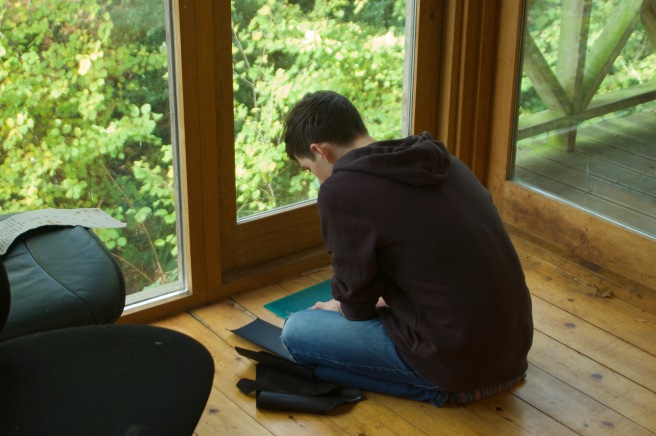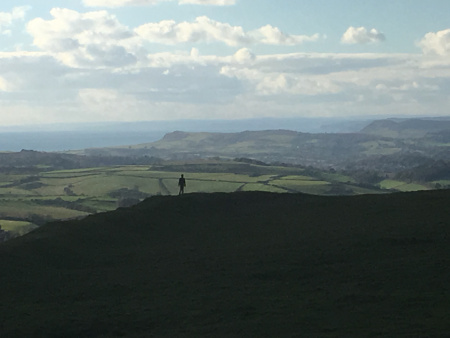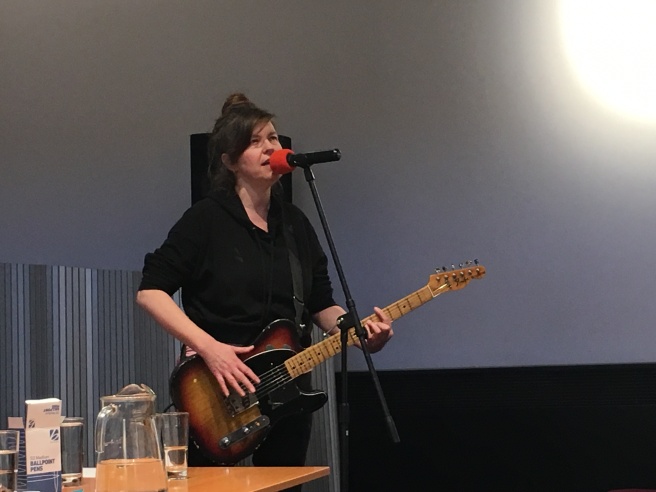My 16 year-old son and I were invited by Anna Best to do an arts residency at The Mothership in Dorset at the end of October 2018. This is an account of that week.
We know that we will be doing some work together. We don’t know what we’ll be exploring exactly, and we’re given the freedom to not know. No result is expected – this is luxurious, even decadent, in the best possible way. We’re both at periods of life where there is transformation and change. He will leave home soon, maybe next year, maybe in two years, so I will be looking at what this means to me. I know I want to go deep into whatever I explore.
Practicalities first. We are staying in a studio overlooking a giant oak.

Anna’s beans are drying on one of the shelves:

We have a compost loo which we’ll share with other people, there is no internet. Chris is next door with Simone the dog. We have a vast landscape to wonder in, including a disused railway line. Bridport is 20 minutes drive away and there’s everything we need there, including food shops, pubs and cafes. I’ve brought most of what we need anyway. There are other rural local produce shops and pubs nearby, and it’s not so far from the sea. I pour over maps to get my bearings as I don’t know the area at all. We are near Powerstock, not far from Bridport, and oddly close to places we used to go when we lived in Devon, such as Lyme Regis.
We will present our work at a showing for Force 8 on Friday, 5 days into our residency. http://force8.org is “a creative collective of artists, writers, designers and musicians founded by Anna Best and Hester Schofield in 2016 to promote a culture of thinking and progressive dialogue through contemporary art that will inspire people in Bridport and the surrounding area.”
Where to start? There are many resources available to us: Resource 1. we have brought books. Some are his choice, some are mine.
Resource 2: a random selection of materials. The combination of them is in itself of interest to me. I’ve brought wood cutting tools, paper, inks made out of soil, he’s got threads, wool, knitting needles, an antique wooden milk crate full of materials including paints.
Resource 3: there is a lot of extraordinary nature outside, so our palette is full and there are endless textures and colours to find.
Resource 4: In our application for the residency, we started from a statement that Bede attributed to Plato – “Inside everything, there is a perfect form“ which I think he picked up from studying Ethics and Philosophy. Another way of putting this is that everything in this world is an imperfect representation of its perfect form.

Resource 5: In the summer we were in North Wales and my mother, sister, cousin, my children and I had walked to the beach for a swim. On the walk down, Bede made me a boat to hurl away into the sea, as it was my birthday. It was rainy and cold and it was the perfect thing to do. I have brought the photo of this.

Resource 6. Making letters to an aspect of self is my thing…. so I would like to do this. Writing letters to the breath every day makes it easier to catch the journey of the week in the writing – they somehow catch the nub of each day. They give the whole thing a slow paced rhythmic quality.
The first thing I do is ditch any idea of a plan, or a list or any tightening around my waist. I do keep looking out to check Bede is ok though….
Watching your mother go into a deep creative zone in an almost off grid rural location and having no-one else about isn’t every son’s dream. And you might be amazed he actually came at all. Well so am I, and it isn’t all smooth…
“How long are we here for?” he says on day 2, impatiently.
“Seven days” I say.
“But what exactly are we doing here?”
“Making things, I don’t know, it doesn’t matter. Just making art. You know that. You wanted to come!”
” I don’t want to do an arts project, he says. I want to be at home.”
And there was the ‘You’re so deep mum’. It wasn’t a complement.
‘Yes, I am.’ I say, simply and get on with sewing fragments of text onto a piece of paper.
After that he settles in, or just gives in and finds what this is about for him. Unstructured time, un-led… no one is telling us what to do and there really aren’t many people around… all this is fine. It’s such a contrast to the stitched up quality and quantity of time in the rest of life… school, jobs, volunteering, walks, Duke of Edinburgh, Ten Tors, and so on. There is certainly no manual of how to go about making a piece of work here. Physically and in atmosphere, the place is remarkably like the farm we were lucky to be able to live on in mid Devon for eight years, before we moved to North Somerset.
I offer to give him structure, which he refuses, but I throw out a few lines in case he wanted to catch them. Such as a quote I’d been told at a wedding the day before we’d left. “When you change the things you notice, the things you notice change.” This goes down surprisingly well.
 But if we’re open to noticing the perfect form of everything, then which parts of what we encounter will get sketched onto my notepad, or scratched into something he is making? What form will we use to pull it into a piece of work? Will we even make a piece of work together?
But if we’re open to noticing the perfect form of everything, then which parts of what we encounter will get sketched onto my notepad, or scratched into something he is making? What form will we use to pull it into a piece of work? Will we even make a piece of work together?
The time we have at The Mothership is during the week of the end of October, our Halloween; this was once seen as the thirteenth month. I read about October and November in Ian Siddons Heginworth’s book ‘Environmental Arts Therapy and The Tree of Life, A monthly guide for your soul’s journey on this beautiful earth.’ I read slowly as I like to let the thoughts of writers that I like seep through me, not just over me… though perhaps I’m just slow, and it’s my way of justifying it. His words make more sense to me whilst in this landscape than they would have done at home. You might say they enter me as much as the surroundings, the elements, the fierce winds on our last night there.
We don’t garden as we’d thought we would, so it is more about the landscape, the stories, the fire, the materials we find in these places. We visit the sea and the fossil cliffs.
We have walks in the forest next to the house, alone and together in various changing lights.
”I’m blowing through the elder” he says. ‘It’s pithy inside. You can easily remove the pith”. He’s carved out holes and blows the top, I hear it make a trembling airy sound. Then he shaves a bit more, and the sound disappears. That’s perfect, I think. It’s a silent recorder. And just then steam shoots out of a log.”
Everyone who walks into the space or we come upon becomes part of the work. The stories of everyone who we talk to, influence us or are woven in. The theme seems to be around cuts, threads, sewing up, tracks, circles. A saying goodbye, and a what next? Quite often words elude me, and I confuse words with others – he’s quick to point it out. That’s creative brain at work. He’s got to write an application to a school. It irritates me to have to get that bit of my brain out (the left hemisphere), but of course I’m going to help. I don’t want him to leave home just yet, yet if that’s what he needs, that must happen. We go to an internet cafe to do it.
So in the end how do you choose the right thing to put into this grand sketch of a mother-son moment in time, and what to leave out? Perspective is necessary, to distinguish between the irrelevant details and if no-one else is there to do it, eg a dramaturg, a work partner, it takes longer. I’m already making excuses for the unformed quality of my work. Yet there’s a joy in staying as free in ideas as possible for as long as possible. On Thursday night, I start to create something in script form. I am still pulling threads together when Hester and Anna arrive at 5 pm on Friday for the showing. Bede has lit a fire dish outside.
I haven’t expected it, but the making of objects, the formation of ideas, our creative journey becomes the main thread of the script. There is also something emerging about rising to the challenge of being an elder, in spite of not really wanting to be.
The showing
A fire dish. Stories. Everyone who is there tells a story, each one brings something new to the circle.
This is Bede’s story, though it’s changed and refined and perhaps got both more factually accurate and more poetic in retellings since. ‘If you cast your eye across the bay towards Plymouth, you can see Eddystone Lighthouse. Eddystone built his lighthouse out of wood and glass, and to show off how well built it, he decided to sleep over inside it, for the first night it after it was completed. And that night a great storm came, an unlikely storm, and swept it all away, and him with it. So I was on the sea, on the way to France, thinking of this story. I looked out of the horizon and I could see the world was round. You can’t get that perspective on land. We can make the land straight by building railways, but the sea will always be round. Railways were built across America, they cut off Buffalo paths. We westerners build roads, square buildings, straight lines…”

Bede also shows what he made… the silent elder recorder. A bamboo pen. A mini church door. A book bound in leather and filled with painted images: the images illustrate cell division. A thick knitted something which ‘has not become anything yet’, but then becomes a circle, a cowl. He tells a story around a fire dish. He composes a song.

I make a series of letters, in ink and red thread. Seven stories joined by breaths, stitches, insults, home truths. I then write a 24 minute script which is finding what it is.
What does Bede think about what we have made? He likes the fires and the stories but he doesn’t want to hear what I have written. Of course. But he doesn’t mind I’ve written it.
What do I think of what we have made? Perhaps I have made something out of the extraordinary ordinary – this place, the occasion, just having a week to play with. Or even something ordinary extraordinary? I like it when Anna says the studio looks like we’ve been living there for weeks – I suppose we have let ourselves get pretty messy at times. I hope I have not been sentimental, and I hope it gets people feeling something, but know I’ll need to do a lot of cutting.
When I read my words, I see that my metaphors are thick and deep, where as Bede’s thoughts are so clear, even if not simple. Does this make him a better artist than me? I know the detail can confuse the whole, and I need time to work out which is which.
What medium should this writing end up as, I ask at the showing. I’m not so sure yet. Theatre? Radio? Novellette? Long poem? Hester suggests it’s radio, it’s so internal. “You really need to stop and listen to the words, the words are enough in themselves.” I agree, and think that the character called Time could blossom if on radio. Hester sees it as a working through, an interpretation of a dream, or the unconscious, through referencing the every day. Anna says that though some of the references are familiar (she’s lived her for some time, and visited since a child), that this doesn’t make it dull. Knowing a place for years, seeing it through seasons and periods of life, seeing the same thing again and again just makes it richer, deeper, and hearing about it from different perspectives is part of that depth.
Yes – life gives everything we need. When you change the things you notice, the things you notice change.
I ask Hester and Anna to create their own letters to the breath which they do, speedily. I hang them next to my letters, at the window overlooking the oak tree.

Then they tell their own stories beside the fire. Both pick up on themes and leave something new to this story. We blow breaths to each other and receive them back and then go back to our lives.
This whole thing is a walk through something, the 13thmonth, a ritual, a song. It feels as though it touched something honest and true, but I can’t yet understand it – how could I?
I look up my notes of a workshop I went to the week before the residency, about building your dream idea. One of the exercises is a visualisation. I read my account of the visualisation – my vision if you like: it’s about a tall lighthouse by the sea, I am at the top of it talking to a big crowd, helping millions of them see differently. Let’s hope that vision doesn’t get dashed into the sea, I’ll have to build it with better materials than Eddyson used.
My youngest son comes for the last day, after his trip to London where he spent time with my mother. He’s been to the holocaust exhibition at The Imperial War Museum and played Fortnight with his cousin. I encourage him to create something. This is what he makes: 
“So for now the cycle is ending…. Down by the water’s edge, our ship awaits” writes Ian Siddons Heginworth
Thank you to:
The Mothership and Anna
Bede
Iris
Ian Siddons Heginworth; Environmental Arts Therapy and The Tree of Life, A monthly guide for your soul’s journey on this beautiful earth’
Hester, for recommending ‘If Women Rose Rooted: A journey to Authenticity and Belonging’ by Sharon Blackie, which I’ve been reading since.
Richard Mabey’s Flora Britannia
Christopher Hammond
Serena Inskip
The Viking I met at Adele and Nic’s wedding.
Eggardon Hill, which we could see each day, and our friends at 3CaneWhale whose beautiful song ‘Eggardon Hill’, sent little ripples to us throughout the week.











 But if we’re open to noticing the perfect form of everything, then which parts of what we encounter will get sketched onto my notepad, or scratched into something he is making? What form will we use to pull it into a piece of work? Will we even make a piece of work together?
But if we’re open to noticing the perfect form of everything, then which parts of what we encounter will get sketched onto my notepad, or scratched into something he is making? What form will we use to pull it into a piece of work? Will we even make a piece of work together?








You must be logged in to post a comment.